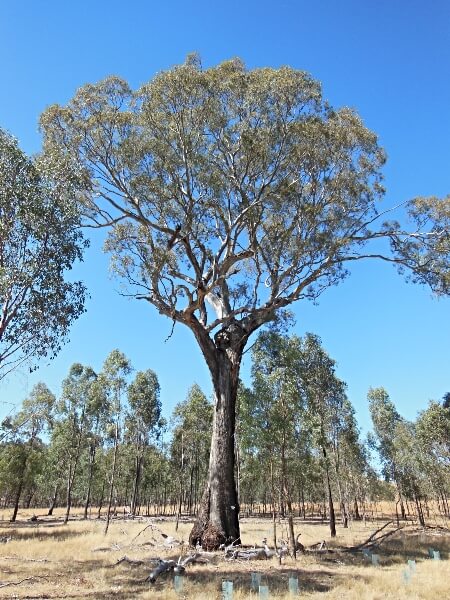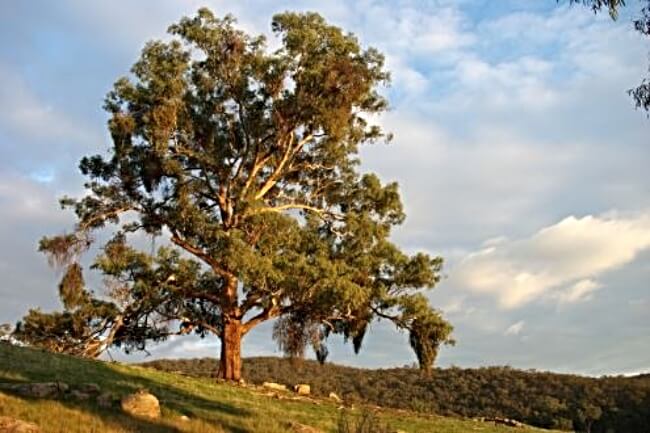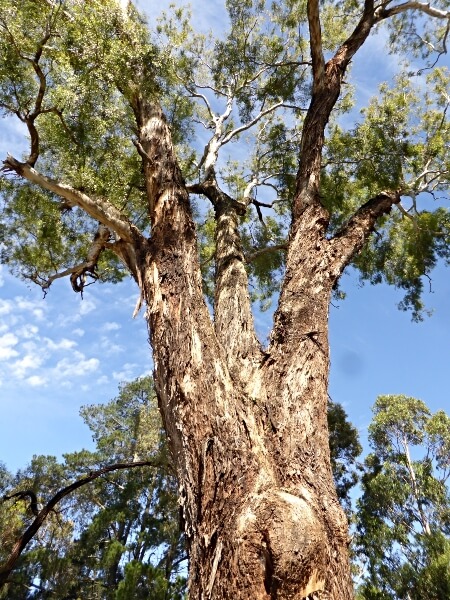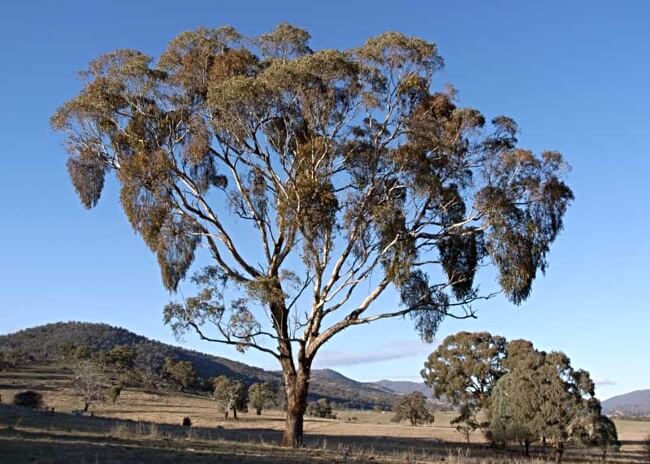The Latin name of Eucalyptus melliodora means ‘the scent of honey’, giving you an idea of how beautifully scented its flowers are. You may often see the honey box tree growing along streets as this popular tree is fairly well-behaved and resilient, so much loved by landscapers as it adds to the sensory experience of its place.
Melliodora is normally quite slow-growing and has an attractive rounded crown to the canopy. It is festooned with its highly scented, white, typical Myrtaceae flowers during the warmer months. It promotes environmental sustainability too, so is a great choice for both aesthetics and wildlife.
At 30m tall, it is too big for small gardens, but great for more generous outdoor spaces, and responds well to coppicing, which can be timed with flowering for added effect. This article is packed with even more tips on growing, caring for and propagating Eucalyptus melliodora.
More...
Family: | Myrtaceae |
|---|---|
Genus: | Eucalyptus |
Species: | E. melliodora |
Common names: | Yellow Box, Honey Box, Yellow Ironbark, Honey Scented Gum, Yellow Jacket |
Origin: | Australian native |
Location: | Outdoor |
Type: | Medium - Tall Tree |
Growth: | 30m tall |
Sun requirements: | Full sun |
Foliage colour: | Green |
Flower colour: | Creamy white |
Flowering: | Most months |
Edible parts: | Leaves are occasionally used to make herbal tea |
Maintenance level: | Low |
Poisonous for pets: | Toxic to cats and dogs |
What is Eucalyptus melliodora?
Eucalyptus melliodora, commonly known as the Yellow Box, Honey Box or Yellow Ironbark is a native evergreen tree that typically grows to a height of 30m (98ft).
This Eucalyptus species is best known for its unusual bark that varies in colour and texture throughout, from very rough at the base of the trunk to almost entirely smooth as it gets to the branches and canopy.
The smooth bark of E. melliodora comes from the shedding of the rough outer bark throughout the year. The bark of E. melliodora can boast colours of greys, browns, reds and yellows giving interest all year round.
Part of its appeal to wildlife is in its benefit to pollinators and small nectar-feeding birds, as it flowers for most of the year.
Many eucalypts have lignotubers, including E. melliodora, which help them to recover quickly from any destruction of the plant. The lignotuber acts as a failsafe for the plant so that it can regenerate after forest fires and very heavy coppicing.
Yellow Boxes' Natural Habitat
Yellow Box tree can be found naturalising in Western Victoria, New South Wales and semi-central Queensland in grassy woodland or similar woodland areas.
Eucalyptus melliodora thrives in humid habitats much like its eucalypt relatives. It is at its happiest and grows naturally where the climate is sun-tropical with a higher annual rainfall but doesn’t tolerate areas with a higher water table.
Their natural soils, as implied by rich, grassy ground cover, are rich, alluvial soils, with well-drained nutritious, loamy composition, but they will grow in sandy loam.

Source: Christopher Jones' Research
Common Uses for Yellow Boxes
Like many other species of Eucalyptus, E. melliodora has been noted for its use of hardwood giving a strong and durable timber used for building and construction.


Get Your Free Guide:
Master Growing Australian Natives eBook
A Must Have Complete Guide for Every Australian Garden
Get Your Free Guide:
Master Growing Australian Natives eBook
A Must Have Complete Guide for Every Australian Garden
Its wood is also an excellent source of fuel and can make high-quality charcoal.
Horticulturally, it is best grown as a full-sized tree and allowed to reach maturity, with a highly ornamental form and wonderful scent all year round.
Edible Uses & Identifying Eucalyptus melliodora
Although there is no known edible use, Eucalyptus melliodora is an incredibly important source of nectar for the production of eucalyptus honey in Australia. The honey that results from yellow box is said to have higher health benefits due to the presence of Eucalyptol found naturally within all Eucalypts.
This all-important nectar is extremely beneficial for wildlife, proving to be a valuable resource not only for classic honey-producing pollinators, but for nectar-eating birds and bats.
In contrast to other Eucalyptus, yellow boxes' leaves are opposite at the beginning of the branch and then turn to alternate with an intramarginal vein. The leaf itself is both lanceolate shaped and elliptical with a greenish grey colour, but distinctly non-glaucus. They have notably smaller leaves than other eucalyptus.
Eucalyptus melliodora can also be identified by a colonisation of mistletoe, but this usually only occurs when the tree grows in isolation, and can be problematic for the tree as the parasitic plant can harm growth on the section it inhabits.
When grown within a healthy ecosystem, Eucalyptus melliodora can usually keep mistletoe in check, so the two have a more balanced relationship.
How to Grow Eucalyptus melliodora
Growing Eucalyptus melliodora is straightforward, but comes with a few more caveats than most in its genus. Eucalyptus are famously forgiving plants, and E. melliodora will be too.
However, the more help you give it to establish, the faster it will develop, and the sooner you will have that iconic canopy over the garden. In the guide that follows, we’ll look at soil conditions and climate preferences, but also some specifics about propagation and pest control.
Best Position for Growing Eucalyptus melliodora
Eucalyptus melliodora is well suited to a range of conditions but does prefer loamy, well-drained sites. In terms of physical location, you should aim for somewhere large enough to accommodate a wide canopy, and where a potentially 30m tall tree can sit well in years to come.
For many gardeners, that rules out growing these trees altogether, but you can coppice them for smaller yards, and even grow them against walls when cut back regularly to make the most of their smaller foliage, which will also encourage flowering closer to the ground where you can truly appreciate it.
Soil & Drainage
Yellow box can tolerate most soil types, from heavy clay to a sandy, gritty, ground. Like other Eucalyptus species, it thrives in well-drained soil but can tolerate waterlogged situations surprisingly well, and once established are drought tolerant plants.
If you have very poor soil, add plenty of organic matter (use leaf mould or garden compost) to improve the soil structure, and consider mulching annually for the first couple of years to help build a better soil biome.
Light & Temperature
Honey box prefers a sunny position in fertile but well-drained soil. When dormant they can withstand temperature lows of around -7°C, but it is important to thickly mulch younger trees to protect roots.
Eucalyptus melliodora will thrive in the sunniest position you have in the garden and will provide excellent shade which can be a godsend in the baking summer months. They are a great asset for a wildlife garden, and will provide other complimentary planting opportunities for shade loving plants too.
In particularly dry summers, it is worth watering young trees to help them cope with drought, but they can withstand extreme highs and reasonably low temperatures so are widely considered hardy.
Planting Eucalyptus melliodora
Most eucalyptus trees are shallow-rooted and don’t like root disturbance, so a well-placed position for this species is crucial to avoid wind rock. Once you’ve found the right spot, it's all about getting the planting right.
But once that’s sorted, and your soil is prepared it’s a simple case of digging a hole, big enough to accommodate the root ball and encourage outward growth. We recommend a planting hole twice the size of the root ball, and square, not round. This prevents young roots from spiralling.
After planting, stake the tree and loosely tie it to allow it to rock gently, but not excessively while the roots get anchored.
How to Propagate Eucalyptus melliodora
Eucalyptus melliodora is best grown from seed, offering gardeners an easy way to make more plants for free. This is especially useful if you are planning a coppiced honey box hedge, or growing plants on as gifts for friends.
But, for the braver souls amongst us, you can also propagate these spectacularly scented trees from grafted cuttings. Sadly, cuttings from Eucalyptus melliodora are even less reliable than most Eucalyptus, so seed germination and grating are the only options.

Source: Castlemaine Flora
Propagating Yellow Box from Seeds
Eucalyptus melliodora can be successfully grown from seed without much preparation. Cold stratification can help aid germination but is not entirely essential, and as the seed pods are filled to the brim with seeds, it's worth having a go the easy way first, because some are almost guaranteed to germinate.
To propagate honey box from seeds you will need a seed tray, filled with a mix of compost (75%) and perlite (25%), and a warm, bright, sunny spot where you can easily keep an eye on soil moisture levels.
Scatter eucalyptus seeds thinly over the soil surface, and water lightly from above until the soil surface is evenly moist. Germination can take several weeks, so be patient, and lightly water the soil every few days or when it begins to dry out.
Once germinated, prick out seedlings when they reach around 10cm tall and have enough roots to handle easily. Once re-potted, let them fill the pot with roots. Minimal repotting will ensure the roots of your seedlings won’t get too disturbed.
Note: Most eucalyptus seeds have long viability, storing well in cool, dry conditions for around five years. When stored eucalyptus seed is sown, a period of stratification can help to trigger germination.
Simply place the seeds in an airtight bag in the refrigerator and leave it for 3-5 weeks. When you remove the seed they should be sown straight away as the warmer temperatures then trigger germination.
Propagating Honey Box from Grafted Cuttings
Honey box takes poorly from cuttings, even more so than most species of Eucalyptus, so grafting is the only option if you prefer to get a head start on seed sowing. However, if you haven’t practised grafting before there is one frustrating caveat – you need a rootstock grown from seed before you can start.
If you have that, you’re all set. Just take a cutting as you ordinarily would (15cm of semi-mature growth, with leaf buds but no flowers) and trim the end of the cutting at a node. Cut a slice in the grafting rootstock, having removed the top growth, and tape the cutting securely into the slit, ensuring firm contact at all points.
The graft should take quickly, so keep the soil moist, and mist the graft point occasionally to stop it from drying out until you see signs of growth.
Caring for Eucalyptus melliodora
Depending on where your E. melliodora is positioned it may very well take care of itself, and mature trees will need no care at all, other than to remove dead, damaged or diseased branches.
Most honey box care comes when the tree is coppiced, and pruning is therefore a more religious affair.
As we mentioned earlier, while Eucalyptus melliodora is young it may need additional water during the summer months in warmer parts of Australia to help it through droughts early in its life, but it will become drought-tolerant as it develops.
Coppicing Eucalyptus melliodora
Coppiced trees have gorgeously lance-shaped leaves, packed with character, and shrouded in flower for much of the year, but it is important to time coppicing perfectly to encourage the best flowering as stems develop.
Some more vigorous, fast-growing, eucalyptus trees require coppicing every year, but Eucalyptus melliodora can be left for three or even four years between cuts. This gives optimum height, a variety of leaf textures, and reliable flowering throughout the year.
We would also advise strongly towards cutting every other stem, every two years. That means that each stem has four years of growth, but the tree can remain in flower perpetually.
Common Eucalyptus melliodora Pests and Diseases
There are some specific pest reports on honey boxes, but the species is not usually affected by pest damage, nor is it commonly touched by disease.
Obviously, there are some common fungal issues, and its preferred habitat of well-drained loam can cause challenges by itself, as the most commonly over-watered ground type. But, with a little luck, and a lot of care, you can prevent and treat the most common pests and diseases on yellow boxes.
Yellow box lace lerp
Yellow box lace lerp is the pest to look out for, partly because they spread fungal leaf infections, but also because they are almost unique to this plant and, up close, they are really quite beautiful.
Ok, so lace lerp is a pest, and yes, it damages your plants, but if you get really close up, or view them through a magnifying glass, they are staggeringly intricate insects. The flies themselves are shockingly dull, but the larvae look like the skeletons of sea shells, or silk lace, moving around foliage and feeding on the underside of leaves.
Sadly, they can spread devastating fungal infections between plants, and as they move from leaf to leaf they spread it further into the plant. So, if you do ever notice grey or yellowing leaves, with patches of dieback, or foliage that has become see-through, check for these pests and remove the affected growth before they spread.
Eucalyptus leaf beetle
Eucalyptus leaf beetle can damage Eucalyptus melliodora in all stages of its lifespan, but is usually not that much of an issue and should be tolerated on mature trees.
Coppiced plants can be managed by removing the pests, which eat leaves at a rapid rate, and lay clusters of eggs on the underside of leaves, which hatch and devour nearby foliage at a rate of knots.
Birds usually help to manage eucalyptus beetles and are already attracted to yellow box for their nectar, so it helps to manage the problem naturally.
Gumleaf skeletoniser
Gumleaf skeletoniser, like lace lerp, is a problem, but a beautiful one. The caterpillar is stunning by itself but the way they consume leaves it quite magical.
I know it's not ideal for us as gardeners to see our beloved plants being eaten, but the way they eat paths through eucalyptus leaves, leaving a wake of hollow structures behind them is incredible.
The fluffy caterpillars are tiny, and covered in fine hairs. When they pupate they emerge into an unexpectedly dull brown moth that flies off to lay eggs elsewhere.
They should be tolerated on mature trees, but removed from young trees. They tend not to spread fungal infections directly, but spores and bacteria can enter into the damaged leaves as a result.
Yellow Box Frequently Asked Questions

Source: Trust Trees Australia
What is yellow box wood used for?
Yellow box wood is used as structural timber. It is durable, rot-resistant, and can be coppiced without killing the tree, making it a great option for heavy-duty, hard-wearing timber. It is not commonly used today but was a useful traditional timber.
Which eucalyptus smells like honey?
Eucalyptus melliodora is the sweetest scented eucalypt, with a distinct honeyed scent that lends itself to the common name – honey box – and aligns well with the tree's famous use as a nectar source in the production of natural honey.
How do I identify a yellow box tree?
Yellow box is not that easy to identify, but if it is in flower the fragrance is very distinctively sweet. The trunk will have peeling brown and grey bark, with smooth pale bark beneath, leading up the rest of the tree. They typically grow to around 30m tall and have even canopies.
Is yellow box wood hardwood?
Yellow box wood is an exceptionally useful hardwood timber, but generally not grown for commercial timber any more, due to the fact it is easier and quicker to grow other gums for the same purpose.
Is Eucalyptus melliodora invasive?
Eucalyptus melliodora is distinctly not an invasive tree. It has been introduced all over the world with no adverse effects on surrounding wildlife or ecosystems and does not appear to commonly cross-pollinate or dilute other gene pools where other eucalypts are concerned.
How wide does Eucalyptus melliodora grow?
Eucalyptus melliodora grows to around 20-25m wide in an even round canopy, offering a gorgeous structure and a wonderful silhouette. If you are looking for a landscape-defining tree for a larger garden or even park settings, there are few other native trees offering this reliably beautiful form.
How close to the house can you plant Eucalyptus melliodora?
Eucalyptus melliodora has shallow but spreading roots, to about 30m. 30m is about the right distance from the house, and while the roots do extend beyond that, they are small fibrous feeding roots, rather than destructive roots and won’t do any damage to property.
Is Eucalyptus melliodora good for pest control?
Eucalyptus melliodora is sort of neutral when it comes to pest control. It will keep mosquitoes at bay like anything in the Myrtle family, but it also attracts pollinating flies, bees, lacewings, wasps, and other insect visitors.
Do rats like eucalyptus trees?
Rats dislike eucalyptus essential oil, but will not be put off by eucalyptus trees themselves. The leaves can be beaten around a property as a general defence, which also helps as a spider deterrent, but the distilled essential oil is much more effective.
Is Eucalyptus melliodora safe for pets?
Eucalyptus melliodora is not safe for pets and is well-recorded as a toxic plant. Dogs, cats, rabbits and other small mammals are extremely vulnerable to eucalyptus toxicity and should not be allowed to chew or eat eucalyptus in any form.
Invite the Soothing Fragrance of Eucalyptus melliodora into Your Garden
While it is, by far, at its best grown as a mature tree, to 30m tall, with a 20m wide canopy, Eucalyptus melliodora is also one of the most effective and ornamental scented hedges you can plant.
It takes a little bit of regular maintenance, and some patience for the full effects to take shape but, once established, a coppiced hedge of honey box is simply unbeatable.
With its sweet honey-scented flowers and low maintenance, this Eucalyptus species is a self-contained wildlife haven and a must in any large native-friendly Australian garden. Eucalyptus melliodora is one of the most important trees for honey-producing pollinators, so if you appreciate honey this is the Eucalyptus species to plant.
Published on February 11, 2025 by Nathan Schwartz
Last Updated on September 20, 2025





